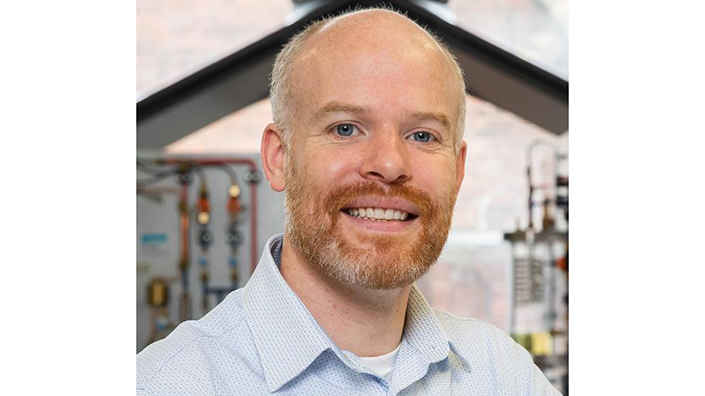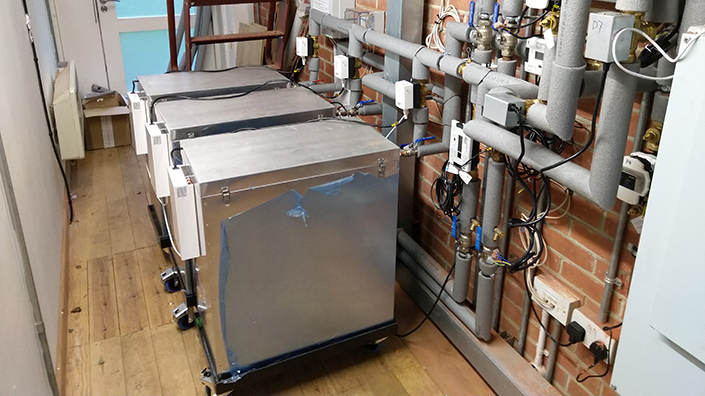Aimed at “disrupting the way we heat our homes”, the project will be testing novel thermal storage in the next few months.
We spoke to Dr Barthorpe about the challenges involved – and his ambitious aims of cutting energy bills and balancing the energy system.
Are the ways that we store energy and heat our homes efficient, from an engineering point of view?
At the moment, most of our home heating is through gas boilers, which has served us for a long time. However, there clearly is a big shift towards moving away from fossil fuels entirely if we can, and emissions from buildings make up such a large proportion of our overall UK emissions. That's an area that is primed for change.
We see that through a number of schemes that the government is supporting, encouraging people towards the adoption of alternatives such as heat pumps. There's support for capital costs of heat pump installations, which can make the difference for some people, but clearly it's not enough on its own.
We've also got changes on the supply side due to the increased penetration of renewables, principally wind but also, for example, solar PV on people's roofs. Storage is going to be needed to meet this mismatch between supply and demand. Our take is to do things at the domestic scale, and have lots of small thermal stores, as opposed to purely relying on huge grid-scale assets, as part of the overall mix.
How do you plan to provide a different way of doing things?
Having distributed storage is a good way to go, and having thermal storage in particular has got advantages over purely electrical storage. One version of the future has got everybody having a lithium-ion battery on their house in order to provide local flexibility, but that's not a brilliant use of lithium-ion batteries. In addition to cost, there are concerns about the materials that are involved and the rate at which batteries degrade.
There are lots of thermal storage options. Hot water tanks are the way that we used to do things, certainly for domestic hot water, if not for space heating. But there have been changes over time. People have often taken out their hot water tanks or replaced them with condensing boilers and other methods for instantaneously creating heat as they need it, rather than storing it. In older properties that space has often been lost to storage cupboards, while in newer properties it may never have been designed in.
So a few of the drivers with ADSorB are looking at different methods of storing heat – some offering greater density, some offering longer duration storage.

Dr Rob Barthorpe
The former is being addressed with the phase change material (PCM) stores that we're looking at. We can get roughly three-times the amount of heat stored per unit volume that you can with hot water, and that's by going from sensible heat storage – essentially heating something up and watching the temperature rise, as you would do with water – to making use of latent heat, taking advantage of the phase change enthalpy associated with melting and solidifying a material.
You put a lot of heat into something to melt it, but you also recover a lot of heat when you let it solidify again, so that's what we're taking advantage of. We’ve been able to choose a material with a phase change temperature that works nicely for a domestic setting, somewhere in the low fifties, which means that when incorporated into a domestic system you can melt it using a heat pump.
It also returns heat at a useful temperature as well. Somewhere in the mid to high forties is really useful for space heating applications, and also for domestic hot water needs such as filling your bath or running your taps.
You are also investigating thermochemical storage (TCS), please tell me more about that.
The notion here is that you can have a material, in this case it’s a form of salt hydrate, that you can dry out and then rehydrate. So when you've got plenty of energy available to you and you're charging, you dry out the active material, and as long as you keep it dry, you can hold on to that thermochemical potential for a very long time – essentially indefinitely. If you wanted to store it for weeks or months, in principle you could do. It could work very well in a future energy grid where we're having to plan for low wind periods and low sun periods. Then when you rehydrate that thermochemical material, you recover the heat again, usually at quite high temperatures recovered depending on the material that you choose.
Our colleagues at Loughborough University have been working on this for a long time and have made great strides with this. We're aiming to move from lab scale to demonstration in buildings, which would be a real first.
Both methods sound radically different to the current ways we heat our homes. What challenges have been solved in the work, and what challenges remain?
The phase change material side is a little bit closer to fruition. There is one commercial product out there already called Sunamp, which is a UK-based company, and they've been manufacturing units for some time for domestic hot water applications. To some extent, the ground has been proven there, but hopefully we can bring a competitor to market.
One of the things we're looking at in our project is state of charge estimation, so how do you work out what's actually in your store, particularly if you've left it for a little while? That's a fairly straightforward thing to do with a hot water tank, because you just put a thermometer in there and see what it reads. If you've got a phase change material, most of the time you're going to see exactly the same temperature, whether it's just started solidifying, whether it's completely solidified. And so we're looking at different methods of overcoming that, through different sensor modalities.

Three 4.5kWh PCM stores in one of the test homes
Every home is different, every demand scenario is a little bit different, so finding that sweet spot that's going to work well in most homes is one of the challenges there.
On the thermochemical storage side, challenges remain I think. It's at a slightly earlier level. Some of those are around the controllability of the discharge of heat, working out what the most appropriate scale is for that technology.
There's all sorts of intricate details around heat exchanger design and reactor design within the units themselves, and optimising that. And questions like the longevity of the material and how you design these things such that they are going to last for perhaps 25 years, and how you demonstrate that.
We're hopeful that we've cracked some of those challenges within this project and the work that has come previously, but the proof of the pudding will be in the testing, so we’re looking forward to seeing how that goes over the next few months as we install these into homes.
What is the capacity of the devices?
With the TCS units, each of the individual modules that we’ve built so far should hold around 45 kilowatt hours (kWh) of heat. The intention had been that we could string three of these together within each of the homes, but for the time being an individual module should be 45kWh or so.
We're actually looking at whether that's the optimal size for a home, because that's quite a lot of heat to make use of. So within the programme, in the second generation of technologies we may well look at different form factors. That may be slightly smaller units, but potentially more of them, treating them almost like cells in a battery that you can operate individually.
For the PCM units, each cell we've deployed in the homes is about 4.5kWh, and we've got three of those in each of the homes.
What benefits could these technologies bring for homeowners and society?
Our aim is that the end user should be able to take advantage of things like tariffs and flexibility services that will hopefully come down the line to reduce their energy bills.
Deployed over many homes, this goes towards making our future grid work. Being able to match demand and supply in a much better way, avoiding things like curtailed wind energy, where essentially the grid pays wind turbine operators to turn their turbines off during periods when they're producing too much. That clearly is a waste on all fronts.
If we're able to make use of that energy to ‘charge people's homes up’, and store that heat in a really cost-effective way, by doing thermal storage instead of electrical storage, that benefits everyone. That benefit should be socialised and returned to people through lower energy bills.
How widespread could their use be in a decade?
The Dinorwig ‘Electric Mountain’ in Wales, our biggest pumped hydro plant, is the biggest one we've got. It's got about 9GWh of storage within it. If we can take a million homes and put in 10kWh or even 100kWh, we could go far in excess of that as thermal storage, at the point of use where people need it, rather than having to ship it through the energy system at times of peak use.
Fingers crossed in less than 10 years we'll be getting products to market, and people will be seeing these sorts of solutions coming online.
For more expertise, register for IMechE's Energy Storage 2024 event. Held at the Etihad Stadium in Manchester on 24 April, speakers from organisations including National Grid, EDF, Energy Systems Catapult, Jacobs, Siemens Energy, Drax and more will discuss energy solutions including batteries, thermal storage, pumped hydro, and green hydrogen technologies.
Content published by Professional Engineering does not necessarily represent the views of the Institution of Mechanical Engineers.